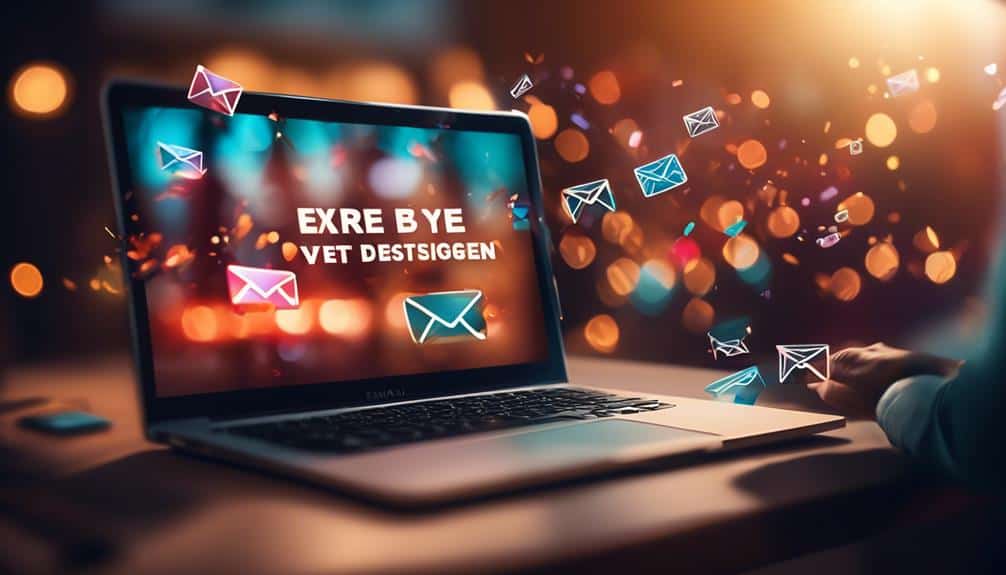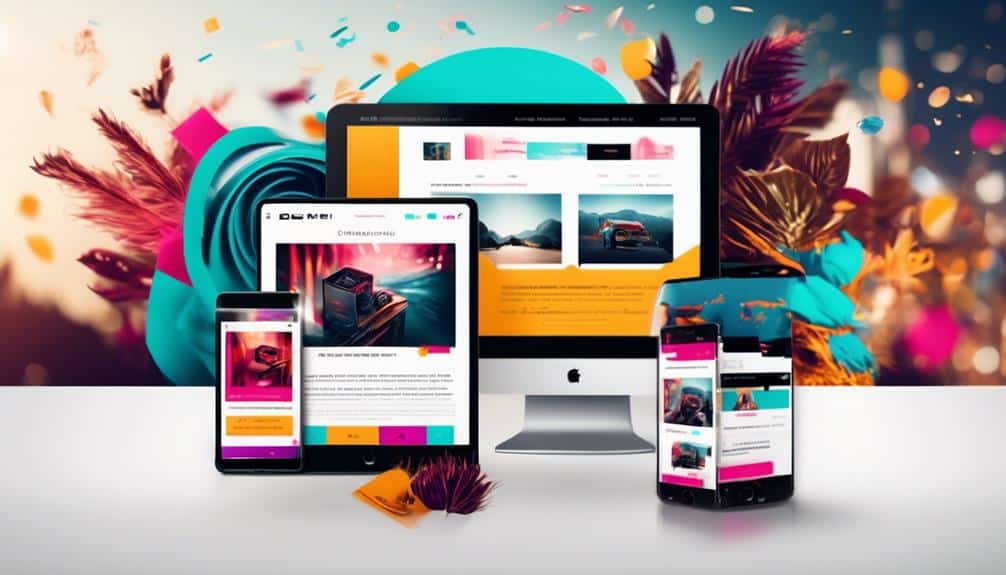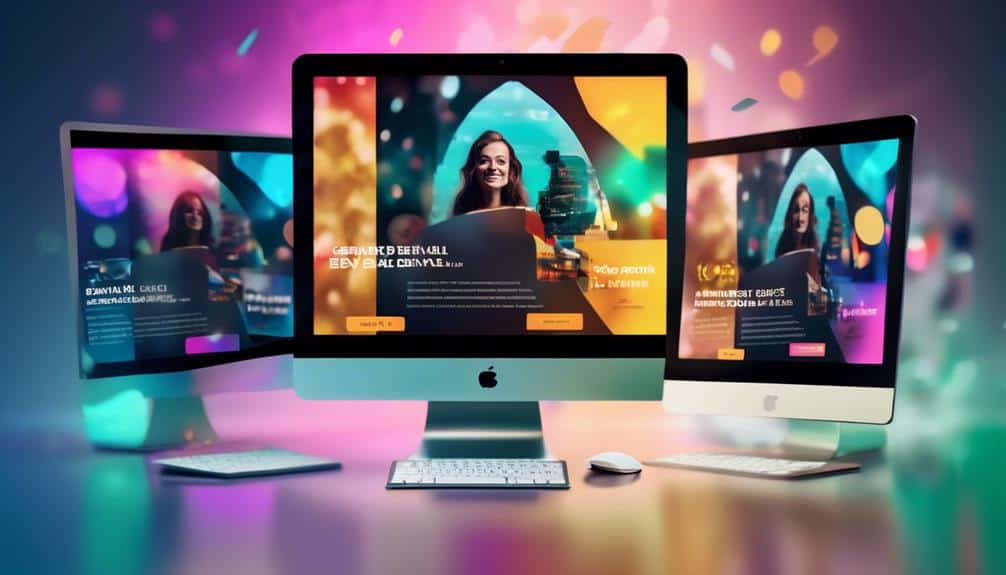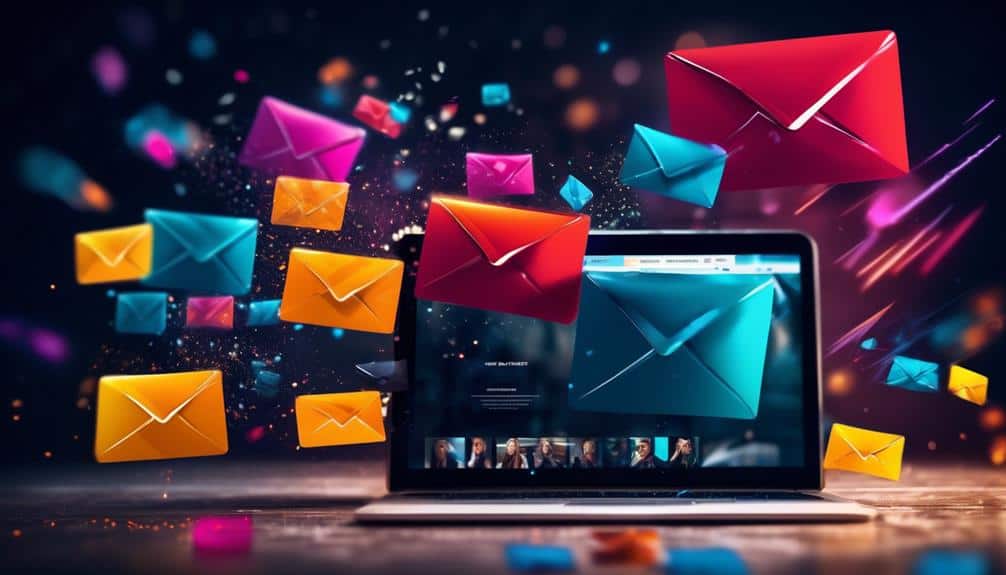Act Fast: Master the Art of Eye-Catching Email Design Before Your Competitors Do
You may think you've got your email marketing game down pat, but imagine the impact you could have if your emails stood out from the rest and grabbed your audience's attention instantly.
The art of eye-catching email design is a game-changer that can set you apart from your competitors in a crowded inbox. By understanding your audience's expectations, utilizing visual elements effectively, crafting compelling content, optimizing layout, and testing and analyzing performance, you can create email campaigns that leave a lasting impression.
But how exactly can you achieve this? Let's explore the secrets to mastering the art of eye-catching email design together.
Key Takeaways
- Eye-catching email designs are essential for maximizing the effectiveness of email marketing campaigns.
- Understanding and meeting audience expectations in email design leads to higher engagement and conversion rates.
- Utilizing visual elements strategically creates impactful and memorable email designs.
- Crafting compelling content, including subject lines and personalized messages, enhances audience engagement and click-through rates.
Importance of Eye-Catching Email Design

Creating eye-catching email designs is essential for capturing your audience's attention and maximizing the effectiveness of your email marketing campaigns. In today's fast-paced digital world, people are bombarded with countless emails every day. To stand out from the crowd and make a lasting impression, you need to incorporate eye-catching design techniques that align with the latest design trends in email marketing.
One of the key design techniques to consider is the use of vibrant colors and visually appealing graphics. Bright and bold colors can instantly grab your audience's attention and make your emails more visually engaging. Additionally, incorporating eye-catching graphics, such as illustrations or high-quality images, can enhance the overall visual appeal of your emails and make them more memorable.
Another important design trend to keep in mind is the responsive design. With the increasing use of mobile devices, it's crucial to ensure that your emails are optimized for different screen sizes. By using responsive design techniques, you can create emails that adapt seamlessly to different devices, providing a consistent and enjoyable experience for your audience.
Understanding Your Audience's Expectations
When it comes to email design, understanding your audience's expectations is crucial. Your audience has unique design preferences, and meeting their expectations can greatly increase engagement and conversion rates.
Audience's Design Preferences
Understanding your audience's design preferences is crucial for creating eye-catching email designs that effectively engage and resonate with your recipients. By aligning your email design with your audience's expectations, you can increase the chances of your emails being opened, read, and acted upon. To better understand your audience's preferences, it's important to stay updated on the latest design trends and leverage the psychology of colors.
Here is a table that outlines some common design preferences and their potential impact on your email engagement:
| Design Preference | Potential Impact |
|---|---|
| Minimalist design | Creates a clean and uncluttered look, allowing recipients to focus on the message |
| Vibrant colors | Grabs attention and evokes positive emotions |
| Personalization | Makes recipients feel valued and increases the likelihood of engagement |
| Mobile-friendly design | Ensures seamless viewing across devices, maximizing accessibility |
| Clear call-to-action | Guides recipients towards the desired action, increasing conversions |
Meeting Customer Expectations
To effectively meet customer expectations, it's crucial to understand what your audience is looking for in your email designs. Meeting customer expectations is the key to customer satisfaction and building long-lasting relationships.
When it comes to email design, customers expect clear and concise communication that's visually appealing and easy to navigate. They want emails that are personalized and relevant to their needs and interests.
Effective communication is essential in ensuring that your customers feel heard and valued. By understanding your audience's expectations and incorporating them into your email designs, you can enhance customer satisfaction and strengthen your brand reputation.
Utilizing Visual Elements for Impactful Designs

Incorporate captivating visual elements into your email design for maximum impact. Visual hierarchy and color psychology are two important concepts to keep in mind when creating impactful designs.
Visual hierarchy refers to the arrangement and organization of elements in a way that guides the viewer's attention and creates a logical flow. By strategically placing important information and calls to action at the top and using size, color, and contrast to highlight key elements, you can ensure that your emails are visually engaging and easy to navigate.
In addition to visual hierarchy, color psychology plays a crucial role in email design. Different colors evoke different emotions and can greatly impact how your audience perceives your message. For example, using warm colors like red or orange can create a sense of urgency or excitement, while cool colors like blue or green can convey a feeling of calmness or trust.
Crafting Compelling Content for Engagement
Are your email subject lines captivating enough to grab your audience's attention?
In order to craft compelling content for engagement, you need to focus on creating subject lines that pique curiosity and entice your readers to click.
Additionally, incorporating visual storytelling techniques can help you convey your message in a more engaging and memorable way.
Lastly, don't forget the power of personalization – tailoring your emails based on your audience's preferences and behaviors can significantly increase engagement and conversions.
Captivating Subject Lines
Craft captivating subject lines to engage your audience and increase email open rates. The subject line is the first impression your recipients have of your email, so it's crucial to make it compelling and enticing. Creating compelling subject lines requires a combination of creativity and effectiveness. Here are some tips to help you write effective email copy:
| Tip | Description | Example |
|---|---|---|
| Keep it concise and clear | Use concise language that clearly communicates the purpose of your email. | "Exclusive offer: 50% off all products!" |
| Use personalization | Personalize subject lines with the recipient's name or reference to their interests. | "John, check out our new collection just for you!" |
| Create a sense of urgency | Instill a sense of urgency by using words like "limited time" or "last chance." | "Only 24 hours left to claim your discount!" |
| Ask a question or make a statement | Engage your audience by posing a question or making a bold statement that piques curiosity. | "Are you ready to transform your business?" |
| Test and analyze | Continuously test different subject lines and analyze the results to optimize your strategy. | "Free shipping vs. 10% off: which offer performs better?" |
Crafting captivating subject lines is an essential skill for engaging your audience and increasing email open rates. By following these tips and continuously testing and analyzing your results, you can create compelling subject lines that grab attention and drive engagement.
Visual Storytelling Techniques
Engage your audience and captivate their attention with visually compelling storytelling techniques.
To create effective visuals that tell a powerful story, consider the following:
- Use vibrant colors and eye-catching graphics to grab attention.
- Incorporate meaningful images that evoke emotions and resonate with your audience.
- Utilize compelling typography to convey your message and create visual interest.
- Experiment with different layouts and formats to keep your emails fresh and engaging.
Personalization for Increased Engagement
To truly captivate your audience and drive engagement, it's essential to personalize your email content in a way that resonates with each individual recipient. Implementing effective personalization strategies can significantly increase email open rates and improve overall engagement with your audience.
One strategy is to segment your email list based on customer preferences or demographics, allowing you to tailor your content specifically to their interests.
Additionally, using merge tags to insert the recipient's name or other relevant information in the email can create a more personalized experience.
Another effective technique is to send targeted emails based on past interactions or purchase history. By understanding your audience and crafting compelling content that speaks directly to their needs and desires, you can cultivate a stronger connection and drive higher engagement levels.
Optimizing Layout for User-Friendliness
Create a visually appealing and user-friendly email layout by optimizing the design for maximum readability. When it comes to email marketing, user experience is key. You want to ensure that your subscribers can easily navigate and engage with your emails.
Here are a few tips to help you optimize your email layout for user-friendliness:
- Use a responsive design: Make sure your email looks great on all devices, from desktops to smartphones. A responsive design will adapt to different screen sizes, ensuring a seamless user experience.
- Keep it simple: Avoid clutter and keep your email layout clean and uncluttered. Use ample white space to make your content stand out and make it easy for readers to scan through your email.
- Use a clear hierarchy: Organize your email content in a logical and visually appealing way. Use headings, subheadings, and bullet points to break up the text and make it easier to read.
- Use clear and concise language: Write your email copy in a concise and easy-to-understand manner. Use bullet points or numbered lists to present information in a clear and digestible format.
Testing and Analyzing Email Design Performance

To ensure optimal performance of your email design, it's crucial to test and analyze its effectiveness. Testing techniques and performance analysis play a vital role in understanding how your emails are resonating with your audience. By using various testing methods, you can gain valuable insights into what works and what doesn't, allowing you to make data-driven decisions to improve your email design.
One testing technique is A/B testing, where you send two versions of the same email to different segments of your audience and analyze the results. This can help you determine which design elements, such as subject lines, visuals, or call-to-action buttons, are more effective in driving engagement and conversions.
Another testing technique is user testing, where you gather feedback from a select group of users who represent your target audience. This can provide valuable insights into how your email design is perceived and whether it effectively communicates your message.
In addition to testing, performance analysis is essential for evaluating the success of your email design. By tracking key metrics such as open rates, click-through rates, and conversion rates, you can measure the effectiveness of your design and make improvements accordingly.
Frequently Asked Questions
How Can I Ensure That My Email Design Stands Out From My Competitors?
To ensure your email design stands out from competitors, create a strong visual hierarchy, craft compelling subject lines, track and measure design effectiveness, utilize interactive elements, implement personalization, and incorporate social media integration. Act now and get ahead!
What Are Some Common Mistakes to Avoid When Designing Eye-Catching Emails?
To design eye-catching emails, avoid these common mistakes: cluttered layouts, excessive text, lack of visual hierarchy, poor use of color and fonts, and forgetting to optimize for mobile devices. Act fast to stand out!
Are There Any Specific Design Trends or Techniques That Are Particularly Effective in Email Design?
Incorporate interactive elements and a minimalistic approach to make your email design stand out. Engage your audience with clickable buttons and simple, clean layouts that grab attention and drive action. Don't miss this opportunity to outshine your competition.
How Can I Effectively Use Visuals in My Email Design Without Overwhelming the Reader?
To effectively use visuals in your email design without overwhelming the reader, focus on creating visual hierarchy. Use bold images sparingly and opt for a minimalist design that keeps the layout clean and easy to navigate.
What Are Some Best Practices for Testing and Analyzing the Performance of My Email Designs?
To analyze the performance of your email designs, use email analytics and A/B testing. These tools provide valuable insights into what works and what doesn't. Act fast and stay ahead of your competitors.
Conclusion
Don't let your competitors steal the spotlight when it comes to email design. Master the art of creating eye-catching emails that captivate your audience and drive engagement.
By understanding your audience's expectations, utilizing visual elements, crafting compelling content, optimizing layout, and testing your design's performance, you can stay ahead of the game.
Act fast and take control of your email design to stand out from the crowd and leave a lasting impression on your subscribers.








